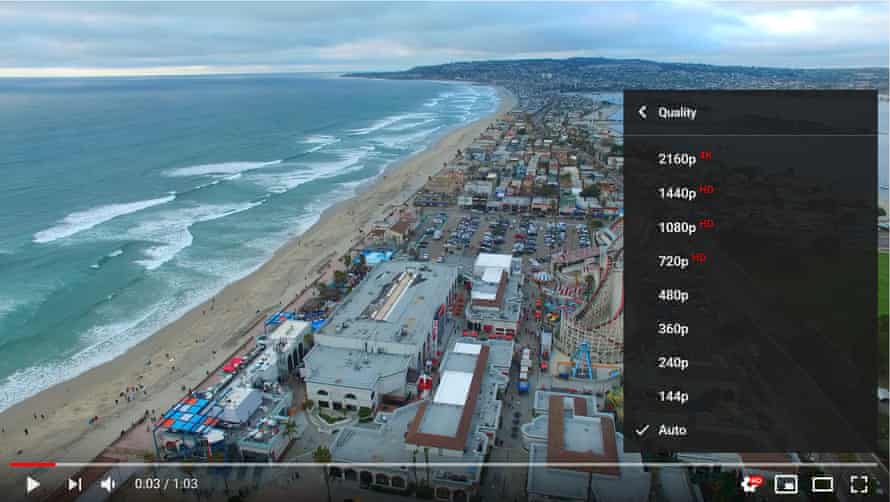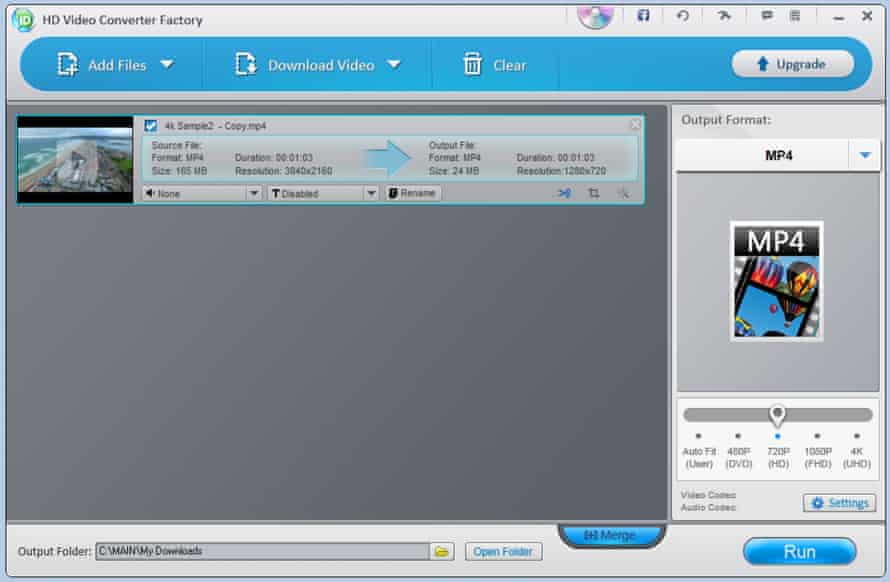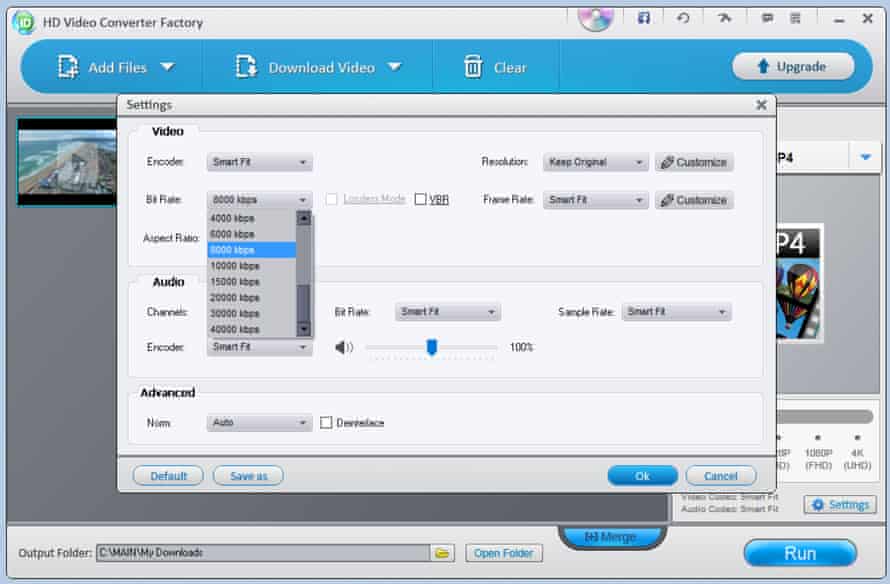Can I Upload a 2 Hour Movie to Galaxy 20
How can I shrink videos so I don't lose a lot of the quality? My phone, a Samsung Galaxy S10, makes really high quality videos but I would be satisfied if they looked similar normal videos. Yanis
Videos take up a lot of space, and a lot of research goes into making them smaller. Other things being equal, a central cistron is the size of the image, just as it is with still photographs. You can besides reduce the file size by arbitrarily reducing the data charge per unit or, for preference, by using a more than efficient video compression organization. The current favourite is MPEG-4/H.264/AVC (Advanced Video Coding), which is usually chosen MP4 for short. Technically, MP4 is the file container while H.264 is the codec that codes and decodes the video.
In that location are some good reasons for reducing video file sizes. For instance, you might desire to customise a high-resolution video for a low-resolution screen. You might likewise want to fit several videos on a device with express storage, such as a smartphone or tablet, or an optical disc such as a CD-Rom or DVD. Yous might want to send the video to someone else; reducing the file size will reduce the upload and download times.
In general, however, information technology's a bad thought to reduce the size of irreplaceable videos just to save space. Disk drives are inexpensive, and a £lxx 4TB drive can hold thousands of videos. You can as well use cheap or free online storage at sites such as pCloud, Mega.nz, MediaFire and Yandex.Deejay.
Screen resolutions keep increasing, and 640 x 480-pixel VGA videos that used to fill up a screen now look tiny on today's 3840 x 2160-pixel 4K screens. So, always shoot at the highest resolution that's practical, and keep it. In the long run, you will need every pixel you tin get.
Earlier we go to the details, a warning: never edit an original video file. Ever keep external backups of original files, and always work with copies. Of grade, this also applies to personal photos and sound files. However, losing a 2GB video of your vacation or a kid's altogether party volition hurt more than losing the odd photo.
Reducing resolution

A standard figurer screen with a resolution of 1280 x 1024 shows ane,310,720 pixels, which is 1.25MB. Your Samsung Milky way S10 tin can shoot videos at an fifty-fifty higher resolution of 3840 10 2160 pixels or UHD (ultra-high definition), where a total screen prototype needs eight,294,400 pixels or vii.9MB – more than six times as much. Even with compression, 30 frames per second adds upward.
If you wanted to customise the video for a Windows laptop with a screen resolution of 1366 ten 768 pixels (1MB per screen), y'all could make it much smaller.
To get some real numbers, I downloaded 4K Sample2.mp4 from the Samsung section of Ashok Patel's AppsLoveWorld website, which offers a few free mp4 video files for testing or demo purposes. If you only want to look at it, information technology'due south also on YouTube. It has been shot from a drone so maybe not a phone, merely either style, this 63-second video takes up 165MB.
Reducing the resolution from 3840 x 2160 pixels (UHD) to 1280 x 720 (Hard disk drive) cut the file size from 165MB to 24MB, so I could almost fit vii videos into the space previously occupied by one. And while it no longer filled my 4K screen, it still looked good quality to me.
I used WonderFox's free HD Video Converter Mill, which reduced the video to 24MB in less than twenty seconds. HandBrake reduced it to 21.3MB but worked the processor harder and took a minute longer. Any Video Converter reduced information technology to seven.6MB with a noticeable loss of visual quality. There are lots of programs that will do this job, so it'due south just a question of finding i you like.
Pro tip: Handbrake can convert a smartphone's variable frame rate videos to a constant frame rate for editing. (It stops the sound going out of sync.)
Attribute ratios

When reducing video resolutions, it is very important to proceed the same aspect ratio (width to acme). If you lot don't, clocks will no longer look round and faces will be distorted so they are either squashed or elongated similar a Modigliani portrait.
Here'due south a guide to the most common resolutions for people who tin't split up 1024 by 576 in their heads.
Today'south most pop video format has a xvi:ix aspect ratio, which is widescreen. This covers HD (1280 x 720), Full Hd (1920 x 1080) and UHD (3840 10 2160). You can also use 1024 x 576, 1600 x 900, 2560 x 1440 and other resolutions while keeping the aspect ratio the same.
Yesterday'south most pop format had a iv:3 attribute ratio, which used to be the standard for TV sets and early monitors. Y'all can convert these videos to and from 640 ten 480 (VGA), 800 x 600 (SVGA), 960 ten 720, 1024 ten 768 (XGA), 1440 x 1080, 1600 10 1200 (UXGA) and 2048 10 1536.
If you have a video with an odd aspect ratio, such as 16:10, so reprocess it to a popular widescreen width while keeping the acme in proportion.
Cutting information rates

When yous reduce the resolution of a video, it fills a smaller surface area, and then you don't need to send the screen as much data. However, in some video editors, y'all can fix the data rate to almost annihilation y'all like. This will reduce the image quality equally well as the file size.
Many people don't perceive or don't intendance near the difference in sound quality between mp3 music files at 128kbps instead of 256kbps or 320kbps. Similarly, many don't care if their videos run at 2-3Mbps instead of 20Mbps or more than. In fact, movie-streaming websites may reduce the data rate from 10-20Mbps to 2-3Mbps because it saves a huge amount of bandwidth.
When I converted the 4K sample higher up, HDVCF automatically reduced the original chip-rate of 21,722kbps to three,346kbs, which is reasonable for the size. Any Video Converter reduced information technology to 996kbps, which was too much. I should have changed the quality setting from normal to loftier.
Alternatively, I could take retained the original resolution and reduced the data rate to a non-too-shabby eight,000kbps. Doing this in HDVCF reduced the file size from 165MB to 61MB, with watchable results. Dropping information technology to 2,659kbps (I asked for 3,000) reduced the file size to 20.2MB while retaining the original resolution, but with poor results – likewise many visual artefacts.
This arroyo works best with static subjects. A video of a talking caput doesn't need equally much bandwidth equally an ice hockey game.
Change the compression

One of the best means to reduce the size of a file is to change the style information technology'south compressed. Today's leading codecs, mainly H.264, are much more efficient than the ones typically used in quondam mpg, wmv (Windows Media Video) and avi files. Video transcoding programs normally take information technology for granted that you'll want to convert any old video into some form of MP4/H.264/AVC.
The catch, of course, is that your processor has to do a lot more than piece of work to decode the higher level of compression. Happily, processors are more powerful than they used to be, and Intel got round the trouble past building H.264 decoding into the CPU, under the Quick Sync Video label. A twelvemonth afterward, in 2012, AMD followed with VCE, its own Video Coding Engine.
Your Samsung phone uses MP4 as standard, merely the settings allow yous turn on "high-efficiency video" and "record videos in HEVC format to save infinite". Samsung warns: "Y'all may not be able to play HEVC videos on other devices or share them online."
Using HEVC would reduce the size of your videos, but I probably wouldn't practise it.
HEVC (high-efficiency video coding) is autograph for H.265, which should have been a shoo-in to supersede H.264, H.263, H.262 and and then on. Unfortunately, it is heavily "patent encumbered" – and Samsung seems to own far more of the patents (4,249) that anyone else.
Along with the patents and patent sharing pools, H.265 brings a dramatic increase in royalties over H.264, plus the threat of content distribution fees. A breakaway grouping has therefore formed an Alliance for Open up Media to create a royalty-free alternative called AV1.
Ordinarily, this wouldn't amount to a hill of beans. In this case, the alliance includes Amazon, Netflix, Apple tree, Google, Microsoft, Facebook, Intel, Arm, AMD, Nvidia, Cisco and … Samsung!
All bets are off until AV1 appears.
Have you lot got a question? Email it to Enquire.Jack@theguardian.com
Source: https://www.theguardian.com/technology/askjack/2020/mar/05/how-do-i-shrink-the-size-of-my-phone-videos